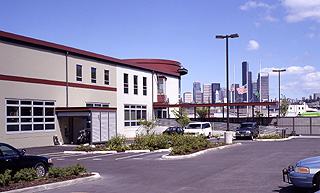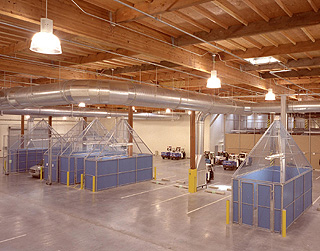
Surveys
DJC.COM
July 28, 2005
Seattle finds gold with sustainable strategies
Special to the Journal

Photos by Steve Keating
The renovated Park 90-5 complex includes a motorcycle wash station that uses recycled water.
|
What brought LEED gold certification to a city of Seattle building project on track for LEED silver? The project team would say that the difference came from collaborative people working with a common goal to build the most high-performance, or sustainable, building possible.
It began with a visionary client. The city decided early on to forego new construction in favor of renovating the Park 90-5 complex on Airport Way South. It made LEED part of the selection criteria for the team to achieve its goal of LEED silver. The result was five LEED-accredited professionals in five disciplines. The team's shared dedication to producing a high-performance building engendered a high level of collaboration among its members.
"Project teams have a choice to struggle with each other and drag each other through the mud, or to work together towards our common goal," said Craig Vierling of Turner Construction. "We all saw that we had much more to gain through cooperation."
Joining Vierling were former city project manager Paul Berry, Phil DeBels of Wood/Harbinger, Marc Jenefsky of DKA, and Joan Hitchner of EEI as commissioning agent.

Police vehicles share space inside with recycled-content storage pyramids.
|
Sustainability strategies
The team's goal for the project wasn't LEED silver. It was to construct the most sustainable building possible within the budget and time constraints. By focusing on high-performance, LEED became the tool used to guide the design towards the goal, rather than the goal itself. It is useful to look at how the team worked together to produce a high-performance facility from older industrial buildings that meets a wide range of user requirements.
Sustainability began early in the process with the city's decision to renovate instead of build new. The city's representative had sustainability on the agenda for every meeting. Team members tracked each other's sustainable issues, helping one another develop alternative solutions.
The city was intimately involved in design decisions, with the process going beyond selecting from alternatives. The design team presented sketches at each weekly meeting, which were discussed and analyzed in depth. The preferred approach arrived at the next weekly meeting in its new iteration.
When the city wanted to bring daylight into an office area, DKA built a model to use with the sun simulator at the Lighting Design Lab. This gave the architect and client a way to see and decide together what size and shape of skylight would maximize the light brought into the building. Adding daylight was the right thing to do for a high-performance building, but did not gain the project any LEED points.
The city wanted a raised floor ventilation system in order to give occupants more control over airflow and temperature in their workspaces. The building had a concrete ground floor, so installing a raised floor would have required expensive demolition.
The upper floor of the building had a wood floor, making it easier to penetrate. By moving the offices upstairs, putting support functions downstairs with conventional HVAC, and distributing the air from one place for both floors, it became economically feasible to build the raised floor system in the offices upstairs.
Without the owner's willingness to consider alternatives, the raised floor ventilation would not have been included. This was another example of making a sustainable design choice that did not produce any LEED points.
Contractor input
| Energy saver |
|
Resources and materials saved on Building C include:
• 31 percent water savings — over 1 million gallons of water savings and sewer conveyance savings per year • 18 percent energy savings — over $1 million savings over 20 years • 99 percent reuse of structural systems and building envelope • 96 percent of construction waste was recycled • 23 percent of all building materials made with recycled content • 22 percent of all materials manufactured regionally • 57 percent of all wood FSC certified • 14 percent of the building used salvaged materials, including reused office furniture, windows, doors, cabinets and ceiling tiles |
The general contractor/construction manager process proved to be an advantage because it brought the contractor, Turner Construction, into the project when design was about two-thirds complete. At that point, Buildings A and C were on track to be LEED silver projects. Turner's decisions took Building C from silver to gold.
Through Turner's initiative, recycled construction waste earned LEED points, as did use of Forest Stewardship Council certified wood. Turner got subcontractors to buy into the green building goals, and its high level of documentation contributed to LEED certification.
One sustainable strategy was to take building or site liabilities and turn them into assets. In this case, Building A had an existing issue with ground water — thousands of gallons were pumped out of it every day. Although Buildings A and C were both owned by the city, they would be used by different agencies. The design team proposed diverting the ground water from its destination in the sanitary sewer for use as irrigation, vehicle washing and toilet flushing in Building C. As both owner and occupant, the city chose this solution and will save 1 million gallons of water usage and sewer conveyance each year.
Team members made good use of existing practices to support their common goal. DKA used specifications to communicate to Turner about the high-performance approach. Turner used scope letters to subcontractors to convey sustainable goals for the buildings, and to solicit their suggestions.
"The subcontractors were an incredible resource for us in building Park 90-5," Vierling said. "One sub proposed finishing the wainscoting on both sides so it could be reversed in 25 years to expose the fresh side. That was one of the great ideas we got from our subs that helped us build a better building."
Turner worked with local lumber suppliers to expand the available sources for FSC lumber in the Seattle area. "After I showed a few suppliers the quantity of FSC lumber we were purchasing for this project, there were more competitive bids for FSC lumber by the time we were doing the second building," Vierling said.
High performance
| Project team (Buildings A and C) |
|
DKA architect Turner Construction GC/CM Haozous Engineering civil Peterson Strehle Martinson structural Wood/Harbinger mechanical/electrical Susan Black & Assoc. landscape design McClaren, Wilson & Lawrie police consultant ERD exterior waterproofing Abundant Renewable Energy wind and photovoltaic consultants EEI commissioning agent |
Some say that high-performance buildings are more expensive and so are only possible under a negotiated contract, not with a traditional design-bid-build approach. No doubt, it can cost more, but some materials are not more expensive, just harder to find. Integrating high-performance goals into the project from the beginning ensures that each element is designed once. This avoids the costly duplication that can occur when LEED is added later.
The cooperation of the contractor is also essential. Specifications and drawings should clearly communicate the high-performance goals for the project, explaining how high-performance products (recycled, non toxic, etc.) are to be used. This way ensures that they have understood and bought into the process. To underscore this, structure the contract to provide fee incentives during construction when identifiable goals are met.
Working with less toxic building materials provides a better working environment for construction workers, as well as the occupants of the completed building. Happier workers increase the advantages of building green.
The sustainable advantage
When LEED is an integral part of the design process, the building may cost more to construct, but when viewed over the long term, savings in energy and maintenance expenses will often justify the initial cost. This advantage may be most attractive to a client like the city of Seattle, who controls both the capital and the operating budgets for its facilities. To fully realize the benefits, the owner's maintenance staff needs training in how to use and maintain the new building.
Project scope
The adaptive-reuse of Buildings A and C originally encompassed 175,000 square feet of extensive renovation on a budget of $18 million. Building C was a 150,000-square-foot tilt-up warehouse built for offices and storage in the mid-1980s. Dating from the 1920s, Building A was a four-story concrete-frame office building needing 25,000 square feet of reconfiguration and renovation of its first floor.
The 2001 Nisqually earthquake caused significant damage to both buildings during the design phase. The added repairs caused project delays and increased the scope.
In its final form, the project became 200,000 square feet of renovation, with a construction cost of $25 million. Building C qualified for LEED 2.0 gold, and Building A achieved LEED silver certification — all for $95 per square foot.
The project succeeded through the dedicated collaboration of the architect, contractor and owner. The effort provided a durable, attractive, state-of-the-art facility for the city, and set an example of how adaptive-reuse projects can not only bring new purpose to old buildings, but can save on future operating costs and achieve LEED gold.
Marc Jenefsky is a principal architect at DKA. Barbara Breckenfeld is a communication and marketing consultant to the design and construction industry.
Other Stories:
- Green buildings can spark economic growth
- Momentum is building to reduce global warming
- Turning waste into environmental, social good
- Let the sunshine in, efficiently
- The hazards of flicking on a light switch
- A road map for Columbia Basin's future
- Canada: A lesson in salmon recovery planning
- Better mapping may change development rules
- What makes a green consumer?
- Farmers, government team up to save fish
- Seattle law firms end their paper chase
- Food industry puts energy efficiency on the menu
- A solution to Hood Canal's lurking pollution?
- Stretching Washington's water supply
- Saving salmon: Now the hard work begins
- Whitewater parks move into the mainstream
Copyright ©2009 Seattle Daily Journal and DJC.COM.
Comments? Questions? Contact us.